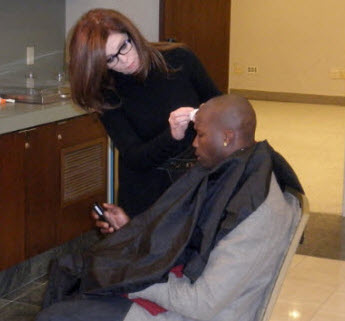GUEST BLOGGER ROSALINA HAS SOME GREAT FOUNDATION TIPS FOR YOU
A More Beautiful Makeup.com
Tips on How to choose a Make-up Foundation
Here are some of my guidelines for creating a flawless complexion: by choosing the right foundation for your skin type.
Always have your skin well moisturized,
Primers are also very useful as they correct the skin tone when needed, give you a smoother looking application and a longer staying power…eg: Mac, Smash Box, Laura Mercier, Urban Decay, Makeup 4Ever
If I was to recommend the perfect foundation for the typical woman, I would actually recommend prescribing 2 shades: one darker and one lighter on either side of your natural skin tone. The lighter shade acts as your highlighter and under-eye concealer, and your slightly darker shade would be used all over as a shader that will help to create a contouring effect by defining your cheekbones and jaw-line, blending it down to the neck. Do not use your neck as a color guide. The neck is usually paler than the rest of the body, match it to you chest color.
You can also alternate, exchange and mix through out the seasons…whether your skin tone gets lighter or darker…· I would also strongly suggest a yellow-based foundation, rather than those nasty pink ones. The reason being that pink foundations are very difficult to to blend into a natural skin tone, and create that horrible “jaw-line effect”.
· For a better foundation, consider your natural skin tone. For example, if you have light olive skin, you should avoid similar shades that end up emphasizing the green in your skin. Choose a contrasting “base tone” color, such as a light peach or violet. If you have a pinky-rosy complexion, choose a green colour-correcting undertone. ( I love this products) :
· Neutral=Adds natural luminosity to the complexion
· Green=Minimizes redness
· Mauve=Counteracts sallow undertones
· Caramel= radiance to fair skin and reduces minor imperfections
· Yellow=Lightens dark complexions
· Pink=Brightens the complexion and counteracts sallow undertones
·
What type of foundation should You choose?
· : Liquid foundation (silicon-based): It’s a mixture of water and silicone and often referred to as “water base makeup” I recommend this type for a normal to dry or mature skin type. The silicon helps to fill in fine lines and large pores, and gives a smoother looking complexion. Silicone-based make-ups are less likely to oxidize or change colour during wear…Refer to my post on Make-up and silicone for a more detailed information…
· Liquid Foundations are also:
· Oil-free- Usually for an oily/problem skin. Oily T-Zone
· Water-Based …for sensitive oily skin
· Smudge proof / water resistant…they have a very long wear… you can get caught in the rain with no worries…Most of the foundations today contain a certain amount of silicone oil or emollients.
· Cream foundation: I ‘m not, personally a huge fan of these, but I use them when I need a heavier coverage, some people wouldn’t use anything else. One word of advise, make sure that you wash your sponge applicator frequently.
Full Coverage Foundations : Generally opaque, used to cover birth marks, vitiligo, hyperpigmentation and scars. It is sometimes referred to as “corrective” or “camouflage” make-up. In general it will contain up to 35% pigment, though professional brands, designed for use on stage, can contain up to 50% pigment.
Powder compact foundation: Coverage from this foundation when applied with the sponge is medium to full. Powder foundation tends to be more matte than sheer or satin. Use a brush for a sheer look. It can also be oil free, some of the powders contain mattifiers.
Same as compact cream foundations as far as usage and application, blends well and has great staying -power..they’re ideal for your handbag and touch-ups during the day/night….
Mineral foundation: For those of you who are very conscious of the products that you use, mineral makeup can give either a light or heavy coverage, depending on your needs and application. I have found through my work that some people who have problem skin, mineral foundations are the only ones that do not irritate their skin. non-comedogenic The terms “natural” and “hypo-allergenic” are not regulated by the FDA and can be used at the manufacturers discretion. Choose wisely as talk is also considerate a mineral… so a talc-based powder could be considered a “mineral makeup”m
Cream and mousse foundations: They can also give you a heavier coverage…
HD Foundations: created for the film and television industry for the new HD technology…they’re fine. An oil-free medium-to-full-coverage liquid foundation that covers skin imperfections flawlessly while remaining invisible on-screen and in real life. This foundation creates a soft-focus effect, which is designed to meet the coverage concerns of those in the spotlight. It leaves your complexion with such a flawless finish, it can withstand bright or harsh lighting.
At the end of the day it comes to preference and what you feel more comfortable using…avoid looking dry and dehydrated..or the opposite greasy.
Blot before applying powder.
Add a moisturizer to the foundation if you find it to thick to work with.
A good foundation should not contain mineral oil, lanolin, or other irritants such as alcohol…
The pump style bottle is a favorite as keeps the germs away. One or two squirt usually does the job.
Brands that I love and use, Make-up Forever, Sappho, Chanel, L’Oreal, Armani, Revlon, Laura Mercier, Mac, Cover Girl,
How to apply it: I suggest on yourself there’s nothing better than your own fingers, second best the “Beauty blender” is very easy to use. Foundation Brushes a great as well































Recent Comments